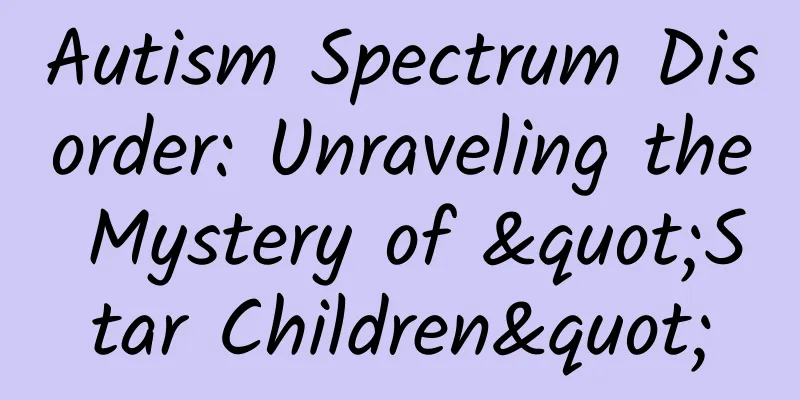Autism Spectrum Disorder: Unraveling the Mystery of "Star Children"

|
In this colorful world, there is a group of children who are like visitors from a distant planet, quietly observing everything around them, but having difficulty integrating into this bustling world. They are children with autism spectrum disorder (ASD), also known as "star children". Today, let us walk into this mysterious and challenging field together and unveil the mystery of autism spectrum disorder. 1. What is autism spectrum disorder? Imagine if there is a huge picture that depicts a variety of interpersonal interactions, language communication and behavior patterns, then autism spectrum disorder is like a continuous spectrum on this picture, from one end to the other, covering a variety of manifestations from typical autism to only mild social disorders. Simply put, autism spectrum disorder is a group of neurodevelopmental disorders characterized by social interaction disorders, language and non-verbal communication disorders, as well as repetitive stereotyped behaviors and narrow interests. 2. The “three core symptoms” of autism spectrum disorder To understand autism spectrum disorder, we have to mention its three core symptoms, which are like three keys to this mysterious world. Social interaction disorder: Imagine that you are standing at a lively party, surrounded by laughter and joy, but you seem to be in another world and cannot really fit in. Children with autism spectrum disorders often feel this way. They may lack the ability to establish normal interpersonal communication with others, have no eye contact, poor expression, and even refuse their parents' hugs and caresses. Among their peers, they find it difficult to establish partnerships and will not take the initiative to contact others, as if they are separated by an invisible wall. Language and non-verbal communication barriers: Language is a bridge of communication, but for children with autism spectrum disorders, this bridge may not be stable. They may not be able to communicate with others through language, and even if they can speak, they may have problems such as delayed speech development, unclear pronunciation, and lack of emotional expression. In addition, they may also lack body language, such as nodding, shaking their heads, and facial expressions, making communication more difficult. Repetitive stereotyped behaviors and narrow interests: Children with autism spectrum disorders often have an unusual interest and obsession with certain things, such as switches, bottle caps, rotating wheels, etc. They can spend hours or even all day repeating these behaviors without getting bored. This stereotyped behavior pattern not only limits their range of activities, but also affects their interaction with the surrounding environment. III. Diversity of Autism Spectrum Disorders It is worth noting that autism spectrum disorder is not a single disease, but a spectrum that includes multiple manifestations. In this spectrum, each child may have different symptoms. Some may only show mild social disorders, while others may have severe language disorders and stereotyped behaviors. Therefore, it is particularly important to use the concept of "autism spectrum disorder" to encompass such disorders of varying degrees. 4. The causes of autism spectrum disorder: an unsolved mystery Although scientists have conducted a lot of research on autism spectrum disorders, its exact cause remains a mystery. At present, it is generally believed that autism spectrum disorders may involve the combined effects of multiple factors such as genetics, environment, and changes in brain structure and function. Genetic factors: Autism has a certain genetic tendency in families, and multiple genetic mutations have been found to be associated with autism. However, not all autistic people have these genetic mutations, so genetic factors cannot fully explain the occurrence of autism. Environmental factors: Certain drugs or harmful substances that the mother is exposed to during pregnancy, as well as complications during pregnancy and the neonatal period, may increase the risk of autism in the child. Changes in brain structure and function: Studies have shown that the brain structure and function of people with autism may be different from those of the general population, especially those areas of the brain responsible for social behavior and communication. 5. How to identify autism spectrum disorder? It is crucial for parents to detect and intervene in autism spectrum disorders in a timely manner. Here are some clues that may indicate that your child has autism spectrum disorders: Late speaking or unclear articulation: The child reaches the age when he or she should speak but is slow to speak, or he or she can speak but his or her articulation is unclear. Slow reaction: Insensitive to stimuli from the surrounding environment, such as no response when the name is called. Social disorders: lack of eye contact with people, poor expressions, and difficulty in establishing normal interpersonal relationships. Repetitive stereotyped behaviors: such as repeatedly opening and closing doors, turning wheels, etc., and never getting tired of doing them. Narrow interests: showing unusual interest in certain non-toy objects. If parents find that their children have the above symptoms, they should seek medical attention promptly and have a professional doctor evaluate and diagnose them. 6. Treatment and intervention for autism spectrum disorders The treatment of autism spectrum disorder is a long and complex process that requires the joint efforts of parents, doctors, teachers and all sectors of society. Currently, the main treatment methods include educational training, psychotherapy and drug therapy. Education and training: Through the development of personalized education and training plans, patients are taught useful social skills. This includes basic self-care skills to more advanced social interaction skills. The cooperation of parents and teachers is crucial, and they need to constantly guide and encourage children in daily life. Psychological therapy: mainly adopts behavioral therapy, cognitive behavioral therapy and family therapy, aiming to strengthen the patient's good behavior and correct abnormal behavior. For example, through the reward mechanism, patients are encouraged to participate in social activities and reduce stereotyped behavior. Drug treatment: For some patients with severe symptoms, doctors may prescribe drugs to improve their symptoms. However, it should be noted that drug treatment cannot cure autism spectrum disorder and can only be used as an auxiliary means. 7. Warm suggestions for parents Facing a child with autism spectrum disorder, parents may feel helpless and confused. But remember, you are not alone. Here are some warm suggestions for parents: Be patient and loving: Children with autism spectrum disorders need more care and understanding. Parents should be patient and tolerate their differences with love. Actively seek help: Don’t be afraid to seek professional help. Keep communicating with doctors, teachers, psychological counselors, etc., and work together for your child’s growth. Create an inclusive environment: Create an inclusive and accepting environment for children so that they can feel the warmth and support from the people around them. Cultivate a wide range of interests: Guide children to develop a variety of interests, which can not only enrich their lives but also help improve their social skills. Pay attention to children's mental health: Children with autism spectrum disorders may be more likely to have psychological problems. Parents should pay close attention to their children's emotional changes and provide psychological support and guidance in a timely manner. Conclusion Autism spectrum disorder is a complex and mysterious field that challenges our cognition and understanding. But it is these challenges that make us pay more attention to those "star children" and strive to create a more inclusive, understanding and supportive world for them. Let us work together to light the light of hope for children with autism spectrum disorder and let them thrive in the sunshine of love. |
<<: Decoding cirrhosis: the liver's "secret battle"
>>: Unlock the secrets of cervical spine protection and self-help for "head-down tribe"
Recommend
How to judge whether grass carp is fresh? How to cook grass carp deliciously
The gill filaments of fresh grass carp are bright...
Wheelchair maintenance tips
Authors: Shen Chen, Gao Dayong; Chief Judge: Zhai...
Women have headaches after sex
Normal sex life for couples is also a process of ...
How long does it take for the new coronavirus to develop? What are the atypical symptoms of the new coronavirus?
Recently, the epidemic caused by the new coronavi...
Symptoms of miscarriage in the first few days of pregnancy
We should pay attention when we are pregnant, bec...
[Medical Q&A] Are there any common sites for breast cancer to occur?
Planner: Chinese Medical Association Reviewer: Ko...
Antibiotic resistance: exploring the future of antibiotics
Antibiotic resistance refers to the increased res...
Causes of breast tenderness before period
Women often experience breast pain before their p...
Are you obsessed with lychee? Beware of lychee disease
"If I can eat 300 lychees a day, I would be ...
How to enlarge breasts for a 40-year-old woman
How can a woman in her forties have a big breast?...
The most obvious signs of pregnancy on day 3
Although pregnancy will cause women's body sh...
Early symptoms of uremia in women
Many female friends have to bear multiple roles. ...
Infographic: SMS Marketing
90% of the world's population has mobile sign...
What kind of food is appetizing and nutritious in summer? Appetizing food
In summer, the diet is mostly light. You can eat ...









